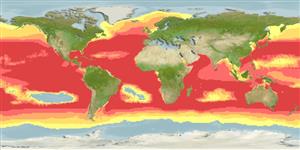Actinopterygii (ray-finned fishes) >
Aulopiformes (Grinners) >
Scopelarchidae (Pearleyes)
Etymology: Scopelarchus: Greek, skopelos = a lantern fish + Greek, archos = anus (Ref. 45335).
Environment / Climate / Range
Ecology
Marine; bathypelagic; oceanodromous (Ref. 51243); depth range 0 - 820 m (Ref. 58018). Deep-water, preferred ?
Circumglobal in warm waters. Eastern Pacific: California Current region off southern California to the Baja California Peninsula. Western Atlantic: Off southeastern USA, the Bahamas, the Gulf of Mexico, and the Caribbean Sea (Ref. 37039). Northwest Atlantic: Canada (Ref. 5951).
Size / Weight / Age
Maturity: Lm ? range ? - ? cm
Max length : 12.6 cm SL male/unsexed; (Ref. 10755)
Oceanic and mesopelagic (Ref. 6601, 58302). Adults have usually been taken in hauls to depths in excess of 500 m although they have also been captured at night in several hauls between 275 to 0 m. Larvae have been captured in hauls restricted to the upper 100 m and have been captured year-round throughout its range (Ref. 10755). Oviparous, with planktonic larvae (Ref. 35929). Synchronous hermaphrodites (Ref. 35929). Adults prey on other midwater fishes (Ref. 6691).
Life cycle and mating behavior
Maturity | Reproduction | Spawning | Eggs | Fecundity | Larvae
Johnson, R.K., 1990. Scopelarchidae. p. 393-397. In J. C. Quero, J. C. Hureau, C. Karrer, A. Post and L. Saldanha (eds.) Check-list of the fishes of the eastern tropical Atlantic (CLOFETA). JNICT, Lisbon; SEI, Paris; and UNESCO, Paris. Vol. 1. (Ref. 10755)
IUCN Red List Status (Ref. 115185)
CITES (Ref. 94142)
Not Evaluated
Threat to humans
Harmless
Human uses
Fisheries: of no interest
More information
ReferencesAquacultureAquaculture profileStrainsGeneticsAllele frequenciesHeritabilityDiseasesProcessingMass conversion
Tools
Special reports
Download XML
Internet sources
